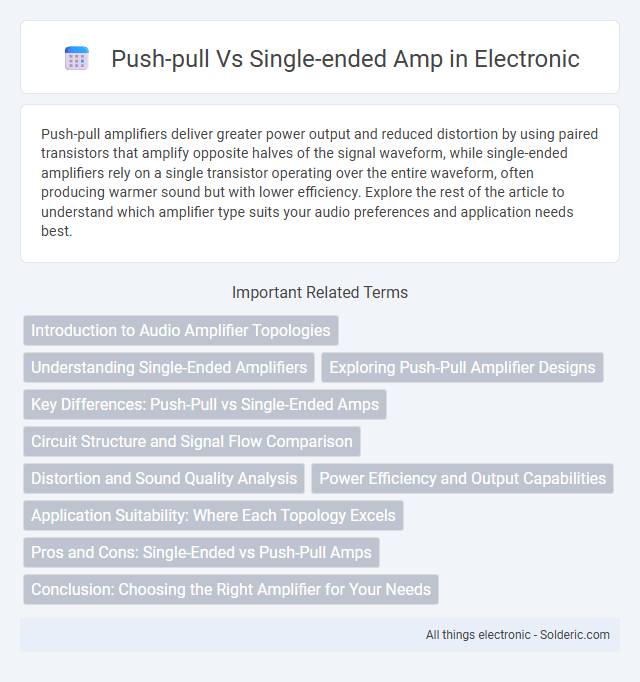Push-pull amplifiers deliver greater power output and reduced distortion by using paired transistors that amplify opposite halves of the signal waveform, while single-ended amplifiers rely on a single transistor operating over the entire waveform, often producing warmer sound but with lower efficiency. Explore the rest of the article to understand which amplifier type suits your audio preferences and application needs best.
Comparison Table
| Feature | Push-Pull Amplifier | Single-Ended Amplifier |
|---|---|---|
| Design | Two active devices drive opposite halves of the waveform | One active device amplifies the entire waveform |
| Efficiency | Higher efficiency, typically 70% or more | Lower efficiency, around 20-30% |
| Distortion | Low even-order distortion due to cancellation | Higher even-order harmonic distortion |
| Output Power | Higher output power capability | Lower output power capability |
| Complexity | More complex circuit and biasing | Simpler circuit design |
| Transformer Use | Typically requires output transformer | Usually requires output transformer |
| Sound Characteristics | Cleaner, more neutral sound | Warmer, richer tonal quality |
| Cost | Generally more expensive due to complexity | Generally less expensive |
Introduction to Audio Amplifier Topologies
Push-pull and single-ended audio amplifier topologies differ significantly in design and performance characteristics. Push-pull amplifiers utilize two active devices that alternately amplify opposite halves of the audio waveform, reducing distortion and improving efficiency. Single-ended amplifiers employ a single active device to amplify the entire waveform, often delivering warmer sound but with higher harmonic distortion and lower power efficiency.
Understanding Single-Ended Amplifiers
Single-ended amplifiers use a single active device to amplify the entire signal waveform, providing simpler circuitry and often delivering a warm, natural sound preferred in audiophile communities. These amplifiers typically have higher distortion levels compared to push-pull designs but produce even-order harmonics that enhance musicality. Understanding your sound goals helps determine if the characteristic sonic signature of a single-ended amplifier aligns with your audio preferences.
Exploring Push-Pull Amplifier Designs
Push-pull amplifier designs utilize two active devices working in tandem to amplify both halves of an input signal, effectively reducing distortion and improving efficiency compared to single-ended amplifiers. This configuration cancels even-order harmonics, enhancing audio clarity and power output, which is particularly advantageous for high-fidelity applications. Your choice between push-pull and single-ended amps depends on the desired balance between sound quality, complexity, and energy efficiency.
Key Differences: Push-Pull vs Single-Ended Amps
Push-pull amplifiers use two active devices operating in opposite phases to cancel even-order harmonics, resulting in higher power output and improved efficiency compared to single-ended amps. Single-ended amplifiers rely on a single active device operating in one conduction cycle, producing a distinctive harmonic distortion and typically lower power with simpler design. Key differences include distortion characteristics, power efficiency, and circuit complexity, where push-pull excels in power and linearity while single-ended amps are favored for their sonic warmth and simplicity.
Circuit Structure and Signal Flow Comparison
Push-pull amplifiers employ two active devices working in tandem, each handling opposite halves of the waveform, creating a balanced circuit with reduced distortion and improved efficiency. Single-ended amplifiers use a single active device amplifying the entire waveform, resulting in simpler circuit design but higher distortion and lower efficiency. The push-pull configuration benefits from cancellation of even-order harmonics due to complementary signal flow, while single-ended circuits provide a direct and linear signal path with inherent harmonic richness.
Distortion and Sound Quality Analysis
Push-pull amplifiers generally exhibit lower even harmonic distortion due to their complementary transistor pairs canceling out distortions, resulting in cleaner sound quality and better linearity. Single-ended amplifiers tend to produce higher levels of even-order harmonics, which some listeners perceive as a warmer, more natural sound despite increased distortion. Your choice between push-pull and single-ended amps will influence the balance between sonic clarity and harmonic richness based on distortion characteristics.
Power Efficiency and Output Capabilities
Push-pull amplifiers exhibit higher power efficiency by utilizing complementary transistor pairs to deliver balanced current flow, reducing distortion and heat dissipation. Single-ended amplifiers, while simpler in design, often suffer from lower efficiency and higher distortion due to their reliance on a single active device handling the entire waveform. Push-pull configurations enable greater output power capabilities, making them suitable for high-frequency and high-power applications compared to single-ended designs typically favored for their linearity and harmonic characteristics at lower power levels.
Application Suitability: Where Each Topology Excels
Push-pull amplifiers excel in high-power audio amplification and professional sound systems due to their ability to reduce even-order harmonic distortion and improve efficiency. Single-ended amplifiers are preferred in low-power, high-fidelity audiophile applications where linearity and simple circuit design enhance sound purity. Push-pull topology suits scenarios demanding greater output power and efficiency, while single-ended is ideal for delicate signal reproduction and minimal phase distortion.
Pros and Cons: Single-Ended vs Push-Pull Amps
Single-ended amps offer simplicity, producing warm, harmonically rich sound but suffer from lower power and higher distortion at high volumes. Push-pull amps provide greater efficiency and power with reduced distortion, making them ideal for louder output and demanding speakers. Your choice depends on prioritizing sonic warmth and simplicity versus power and clarity.
Conclusion: Choosing the Right Amplifier for Your Needs
Choosing the right amplifier depends on your audio preferences and application requirements. Push-pull amplifiers offer higher power output and better distortion reduction, making them ideal for driving larger speakers or professional setups. Single-ended amps provide a warmer, more detailed sound that appeals to audiophiles seeking clarity and musicality in smaller listening environments.
push-pull vs single-ended amp Infographic

 solderic.com
solderic.com